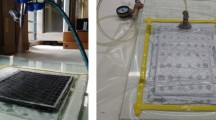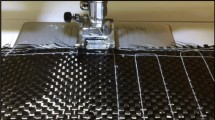Abstract
The aeronautic structures normally operate under high levels of hygroscopic moisture from the surrounding environment at different temperature ranges while in service. Under such conditions, the behavior of laminate composite submitted to cyclic or static loadings can change drastically. In order to understand those effects in stitched fabrics, fatigue tests with open-hole specimens were carried out with a stress ratio of R = −1 and R = 0.1. The specimens were fatigue-tested as provided (environmental conditions) and after exposed to hygrothermal weathering conditions. Based on evidences from recent studies available in the open literature, e.g., effect of water diffusion on epoxy matrix, the overall results indicated a significant reduction in stiffness after the specimens are exposed to hygrothermal effects. The reduction in matrix stiffness, in this case, enhanced the fatigue strength in tension–tension load (R = 0.1) when compared to the specimens in normal conditions. The opposite occurs for the specimens loaded with stress ratio of R = −1, in which the delamination mechanisms changed during the loading reversion from tension to compression that promoted early delamination. Therefore, this process reduced the fatigue life of the specimens under hygrothermal condition. Then, by fractographic investigation, it was verified fracture patterns that regard to mode II damage in R = −1, in which mode II fracture toughness is known to decrease in the presence of water molecules.











Similar content being viewed by others
References
M.Y. Shiino, R.C. Alderliesten, M. Vicente, M. Odila, and H. Cioffi, A Brief Discussion on (Pure Mode I) Fatigue Crack Growth Rate Data in 5HS Weave Fabric Composites : Evaluation of Empirical Relations, Int. J. Fatigue, 2016, 84, p 97–103
L. Yao, R. Alderliesten, M. Zhao, and R. Benedictus, Bridging Effect on Mode I, Fatigue Delamination Behavior in Composite Laminates, Compos. Part A Appl. Sci. Manuf., 2014, 63, p 103–109. https://doi.org/10.1016/j.compositesa.2014.04.007
S.N. Wosu, D. Hui, and L. Daniel, Hygrothermal Effects on the Dynamic Compressive Properties of graphite/Epoxy Composite Material, Compos. Part B Eng., 2012, 43, p 841–855. https://doi.org/10.1016/j.compositesb.2011.11.045
D. Scida, Z. Aboura, and M. Benzeggagh, The Effect of Ageing on the Damage Events in Woven-Fibre Composite Materials Under Different Loading Conditions, Compos. Sci. Technol., 2002, 62, p 551–557. https://doi.org/10.1016/S0266-3538(01)00147-6
E. Vauthier, J.C. Abry, T. Bailliez, and A. Chateauminois, Interactions Between Hygrothermal Ageing and Fatigue Damage in Unidirectional Glass/Epoxy Composites, Compos. Sci. Technol., 1998, 58, p 687–692. https://doi.org/10.1016/S0266-3538(97)00149-8
A. Zhang, H. Lu, and D. Zhang, Synergistic Effect of Cyclic Mechanical Loading and Moisture Absorption on the Bending Fatigue Performance of Carbon/Epoxy Composites, J. Mater. Sci., 2014, 49, p 314–320. https://doi.org/10.1007/s10853-013-7707-9
C. Zhang, W.K. Binienda, G.N. Morscher, R.E. Martin, and L.W. Kohlman, Experimental and FEM Study of Thermal Cycling Induced Microcracking in Carbon/Epoxy Triaxial Braided Composites, Compos. Part A, 2013, 46, p 34–44. https://doi.org/10.1016/j.compositesa.2012.10.006
C. Xiaoquan, Y. Baig, and L. Zhonghai, Effects of Hygrothermal Environmental Conditions on Compressive Strength of CFRP Stitched Laminates, J. Reinf. Plast. Compos., 2010, 30, p 110–122. https://doi.org/10.1177/0731684410384894
F. McBagonluri, K. Garcia, M. Hayes, K.N.E. Verghese, and J.J. Lesko, Characteristics of Fatigue and Combined Environments on Durability Performance of Glass/Vinylester Composites for Infrastructure, Int. J. Fatigue, 2000, 22, p 53
Y. Shan and K. Liao, Environmental Fatigue of Unidirectional Glass ± Carbon Fiber Reinforced Hybrid Composite, Compos. Part B Eng, 2001, 32, p 355–363. https://doi.org/10.1016/S1359-8368(01)00014-2
N.L. Batista, K. Iha, and E.C. Botelho, Evaluation of Weather Influence on Mechanical and Viscoelastic Properties of polyetherimide/Carbon Fiber Composites, J. Reinf. Plast. Compos., 2013, 32, p 863–874. https://doi.org/10.1177/0731684413482994
X. Cheng, S. Liu, J. Zhang, X. Guo, J. Bao, Hygrothermal Effects on Mechanical Behavior of Scarf Repaired Carbon-Epoxy Laminates Subject to Axial Compression Loads: Experiment and Numerical Simulation, Polym. Compos., 2018, 39, p 904–914. https://doi.org/10.1002/pc.24017.
S. Roy, W. Xu, S. Patel, and S. Case, Modeling of Moisture Diffusion in the Presence of Bi-axial Damage in Polymer Matrix Composite Laminates, Int. J. Solids Struct., 2001, 38, p 7627–7641
T. Vo, K. Vora, and B. Minaie, Effects of Postcure Temperature Variation on Hygrothermal-Mechanical Properties of an Out-of-Autoclave Polymer Composite, J. Appl. Polym. Sci., 2013, 130, p 3090–3097. https://doi.org/10.1002/app.39541
S. Choi, A. Phantu, and E. Douglas, Evaluation of the Complex Hygrothermal Behaviors of Epoxy-Amine Systems, J. Appl. Polym. Sci., 2012, 125, p 3778–3787. https://doi.org/10.1002/app
M.K. Bhuyan, M.S. Bhuyan, J.I. Rodriguez-Devora, and M. Yanez, Delamination Behavior of Bidirectional S2 Glass Epoxy Laminated Composite Due to Combined Moisture and Temperature Cyclic Loading, J. Compos. Mater., 2012, https://doi.org/10.1177/0021998312466120
T. Brocks, M. Odila, H. Cioffi, H. Jacobus, and C. Voorwald, Effect of Fiber Surface on Flexural Strength in Carbon Fabric Reinforced Epoxy Composites, Appl. Surf. Sci., 2013, 274, p 210–216. https://doi.org/10.1016/j.apsusc.2013.03.018
H. Liu, M. Li, Z.Y. Lu, Z.G. Zhang, C.C. Sun, and T. Cui, Multiscale Simulation Study on the Curing Reaction and the Network Structure in a Typical Epoxy System, Macromolecules, 2011, 44, p 8650–8660. https://doi.org/10.1021/ma201390k
R. Zenasni, A.S. Bachir, I. Viña, A. Argüelles, and J. Viña, Effect of Hygrothermomechanical Aging on the Interlaminar Fracture Behavior of Woven Fabric Fiber/PEI, Composite Materials, J. Thermoplast. Compos. Mater., 2006, 19, p 385–398. https://doi.org/10.1177/0892705706059743
R.L. Fernandes, M.F.S.F. de Moura, and R.D.F. Moreira, Effect of Moisture on Pure Mode I, and II, Fracture Behaviour of Composite Bonded Joints, Compos. Part B Eng., 2016, 68, p 30–38. https://doi.org/10.1016/j.compositesb.2016.04.022
R. Selzer and K. Friedrich, Influence of Water Up-Take on Interlaminar Fracture Properties of Carbon Fibre-Reinforced Polymer Composites, J. Mater. Sci., 1995, 30, p 334–338. https://doi.org/10.1007/BF00354392
C. Wu and W. Xu, Atomistic Simulation Study of Absorbed Water Influence on Structure and Properties of Crosslinked Epoxy Resin, Polymer (Guildf), 2007, 48, p 5440–5448. https://doi.org/10.1016/j.polymer.2007.06.038
S. Choi and E.P. Douglas, Complex Hygrothermal Effects on the Glass Transition of an Epoxy-Amine Thermoset, ACS Appl. Mater. Interfaces, 2010, 2, p 934–941. https://doi.org/10.1021/am9009346
ASTM D5229/D5229M-92, Standard Test Method for Moisture Absorption Properties and Equilibrium Conditioning of Polymer Matrix Composite Materials, ASTM Int, West Conshohocken, 2004
ASTM D7615/D7615M-11, Standard Practice for Open-Hole Fatigue Response of Polymer Matrix Composite, ASTM Int, West Conshohocken, 2013, p 1–8https://doi.org/10.1520/d7615
ASTM D6484/D6484M-14, Standard Test Method for Open-Hole Compressive Strength of Polymer Matrix Composite Laminates, ASTM Int, West Conshohocken, 2014
A. Rotem, Load Frequency Effect on the Fatigue Strength of Isotropic Laminates, Compos. Sci. Technol., 1993, 46, p 129–138
C.L. Soles and A.F. Yee, Discussion of the Molecular Mechanisms of Moisture Transport In Epoxy Resins, J. Polym. Sci. Part B: Polym. Phys., 2000, 38, p 792–802. 10.1002/(SICI)1099-0488(20000301)38:5<792::AID-POLB16>3.0.CO;2-H
M.Y. Shiino, L.M. De Camargo, M.O.H. Cioffi, H.C.J. Voorwald, E.C. Ortiz, and M.C. Rezende, Correlation of Microcrack Fracture Size with Fatigue Cycling on Non-crimp Fabric/RTM6 Composite in the Uniaxial Fatigue Test, Compos. Part B Eng., 2012, 43, p 2244–2248. https://doi.org/10.1016/j.compositesb.2012.01.074
R. Selzer and K. Friedrich, Mechanical Properties and Failure Behaviour of Carbon Fibre-Reinforced Polymer Composites Under the Influence of Moisture, Compos. Part A Appl. Sci. Manuf., 1997, 28, p 595–604. https://doi.org/10.1016/S1359-835X(96)00154-6
P. Moy and F.E. Karasz, Epoxy–Water Interactions, Polym. Eng. Sci., 1980, 20, p 315–319. https://doi.org/10.1002/pen.760200417
R. Jones, Mechanics of Composite Materials, McGraw-Hill, New York, 1975
L. Amaral, L. Yao, R. Alderliesten, and R. Benedictus, The Relation Between the Strain Energy Release in Fatigue and Quasi-Static Crack Growth, Eng. Fract. Mech., 2015, 145, p 86–97. https://doi.org/10.1016/j.engfracmech.2015.07.018
L.R. Leblanc and G. LaPlante, Experimental Investigation and Finite Element Modeling of Mixed-Mode Delamination in a Moisture-Exposed Carbon/Epoxy Composite, Compos. Part A Appl. Sci. Manuf., 2016, 81, p 202–213. https://doi.org/10.1016/j.compositesa.2015.11.017
M.Y. Shiino, R.C. Alderliesten, M.V. Donadon, and M.O.H. Cioffi, The Relationship Between Pure Delamination Modes I, and II, on the Crack Growth Rate Process in Cracked Lap Shear Specimen (CLS) of 5 Harness Satin Composites, Compos. Part A Appl. Sci. Manuf., 2015, 78, p 350–357. https://doi.org/10.1016/j.compositesa.2015.08.024
E.S. Greenhalgh, C. Rogers, and P. Robinson, Fractographic Observations on Delamination Growth and the Subsequent Migration Through the Laminate, Compos. Sci. Technol., 2009, 69, p 2345–2351. https://doi.org/10.1016/j.compscitech.2009.01.034
M. Charalambides, A.J. Kinloch, Y. Wang, and J.G. Williams, On the Analysis of Mixed-Mode Failure, Int. J. Fract., 1992, 54, p 269–291
M. Blikstad and T.R. Johannesson, The Influence of Moisture and Toughened Resin on the Mixed Mode Fracture of Unidirectional Graphite/Epoxy Laminates, J. Compos. Technol. Res., 2018, 7, p 115–120
T. Lorriot, G. Marion, R. Harry, and H. Wargnier, Onset of Free-Edge Delamination in Composite Laminates Under Tensile Loading, Compos. Part B Eng., 2003, 34, p 459–471. https://doi.org/10.1016/S1359-8368(03)00016-7
A. Hosoi, N. Sato, Y. Kusumoto, K. Fujiwara, and H. Kawada, High-Cycle Fatigue Characteristics of Quasi-Isotropic CFRP Laminates Over 108 Cycles (Initiation and Propagation of Delamination Considering Interaction with Transverse Cracks), Int. J. Fatigue, 2010, 32, p 29–36. https://doi.org/10.1016/j.ijfatigue.2009.02.028
A. Rotem, The Fatigue Behavior of Composite Laminates Under Various Mean Stresses, Compos. Struct., 1991, 17, p 113–126. https://doi.org/10.1016/0263-8223(91)90065-7
C. Soutis, Damage Tolerance of Open-Hole CFRP Laminates Loaded in Compression, Compos. Eng., 1994, 4, p 317–327
C. Soutis, N.A. Fleck, and P.A. Smith, Failure Prediction Technique for Compression Loaded Carbon Fibre-Epoxy Laminate with Open Holes, J. Compos. Mater., 1991, 25, p 1476–1498. https://doi.org/10.1177/002199839102501106
M.Y. Shiino, M.O.H. Cioffi, H.C.J. Voorwald, and E.C. Ortiz, Tricot Stitched Carbon Fiber Reinforced Polymer Composite Laminates Manufactured by Resin Transfer Molding Process: C-Scan and Flexural Analysis, J. Compos. Mater., 2013, 47, p 1695–1703. https://doi.org/10.1177/0021998312450928
M.Y. Shiino, T.S. Pelosi, M.O.H. Cioffi, and M.V. Donadon, The Role of Stitch Yarn on the Delamination Resistance in Non-crimp Fabric: Chemical and Physical Interpretation, J. Mater. Eng. Perform., 2017, https://doi.org/10.1007/s11665-016-2460-2
N.A. Fleck and C. Soutis, Static Compression Failure of Carbon Fibre T800/924C Composite Plate with a Single Hole, J. Compos. Mater., 1990, 24, p 536–558
A. Jumahat, C. Soutis, F.R. Jones, and A. Hodzic, Fracture Mechanisms and Failure Analysis of Carbon Fibre/Toughened Epoxy Composites Subjected to Compressive Loading, Compos. Struct., 2010, 92, p 295–305. https://doi.org/10.1016/j.compstruct.2009.08.010
M. Todo, T. Nakamura, and K. Takahashi, Effects of Moisture Absorption on the Dynamic Interlaminar Fracture Toughness of Carbon Epoxy Composites, J. Compos. Mater., 2000, 34, p 630–648. https://doi.org/10.1177/002199830003400801
A. Rotem and H.G. Nelson, Failure of a Laminated Composite Under Tension-Compression Fatigue Loading, Compos. Sci. Technol., 1989, 36, p 45–62. https://doi.org/10.1016/0266-3538(89)90015-8
Acknowledgments
The authors acknowledge the financial support from FAPESP, through process Nos. 2012/07646-0 and 2011/01937-0 and CNPq Grant 300990/2013-8.
Author information
Authors and Affiliations
Corresponding author
Rights and permissions
About this article
Cite this article
Shiino, M.Y., de Siqueira, G.S.M., Cioffi, M.O.H. et al. Hygrothermal Effect on Composites Under In-Plane Fatigue at Stress Ratios of R = −1 and R = 0.1: An Analysis of Quasi-Isotropic Stitched Carbon Fibers. J. of Materi Eng and Perform 27, 5964–5972 (2018). https://doi.org/10.1007/s11665-018-3584-3
Received:
Revised:
Published:
Issue Date:
DOI: https://doi.org/10.1007/s11665-018-3584-3




